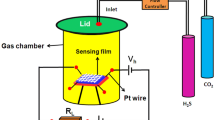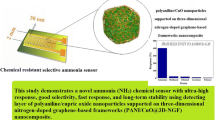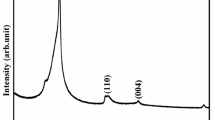Abstract
We report a unique combination of three components in the form of a ternary nanocomposite, PANI/CD/SnO2, for ammonia gas sensing at room temperature. This nanocomposite was synthesized via in situ chemical oxidative polymerization of aniline, in which other components were incorporated to form binary PANI/CD and ternary PANI/CD/SnO2 nanocomposites. The fabrication process initially involved optimization of the PANI/CD nanocomposite and then incorporation of an optimized amount of SnO2 to finally produce the ternary PANI/CD/SnO2 nanocomposite. The ternary composite demonstrated better sensing properties than those of both PANI/CD (1:0.5) and pristine PANI in terms of sensitivity, selectivity, and response time over a concentration range of 5–100 ppm NH3. The response of the PANI/CD/SnO2 nanocomposite was 21.6% towards 100 ppm NH3, which was higher than that of pure PANI and the PANI/CD nanocomposite. The ternary composite exhibited higher selectivity for ammonia over other gases as compared to PANI and the PANI/CD (1:0.5) nanocomposite. The PANI/CD/SnO2 composite also achieved a shorter response time (94 s) than pure PANI (162 s) and the PANI/CD (144 s) composite, and it demonstrated a nearly linear variation in response with the analyte concentration. High repeatability and long-term stability further enhanced the possibility of real-world application of the proposed ternary nanocomposite for practical room-temperature ammonia sensing.








Similar content being viewed by others
References
M. Zulkifli, H. Abu Hasan, S.R. Sheikh Abdullah, and M.H. Muhamad, A review of ammonia removal using a biofilm-based reactor and its challenges. J. Environ. Manag. 315, 115162 (2022).
S.D. Lawaniya, S. Kumar, Y. Yu, and K. Awasthi, Ammonia sensing properties of PPy nanostructures (urchins/flowers) towards low-cost and flexible gas sensors at room temperature. Sens. Actuators B Chem. 382, 133566 (2023).
X. Wang, S. Meng, M. Tebyetekerwa, W. Weng, J. Pionteck, B. Sun, Z. Qin, and M. Zhu, Nanostructured polyaniline/poly(styrene-butadiene-styrene) composite fiber for use as highly sensitive and flexible ammonia sensor. Synth. Met. 233, 86 (2017).
S.D. Lawaniya, N. Meena, S. Kumar, Y.-T. Yu, and K. Awasthi, Effect of MWCNTs incorporation into polypyrrole (PPy) on ammonia sensing at room temperature. IEEE Sens. J. 23, 1837 (2023).
R.P. Padappayil and J. Borger, Ammonia Toxicity (St. Petersburg: StatPearls, 2024).
Y. Li, L. Pan, X. Zeng, R. Zhang, X. Li, J. Li, H. Xing, and J. Bao, Ammonia exposure causes the imbalance of the gut-brain axis by altering gene networks associated with oxidative metabolism, inflammation and apoptosis. Ecotoxicol. Environ. Saf. 224, 112668 (2021).
M.-J. Chan, Y.-J. Li, C.-C. Wu, Y.-C. Lee, H.-W. Zan, H.-F. Meng, M.-H. Hsieh, C.-S. Lai, and Y.-C. Tian, Breath ammonia is a useful biomarker predicting kidney function in chronic kidney disease patients. Biomedicines 8, 468 (2020).
T. Hibbard and A.J. Killard, Breath ammonia analysis: clinical application and measurement. Crit. Rev. Anal. Chem. 41, 21 (2011).
M. Poloju, N. Jayababu, and M.V. RamanaReddy, Improved gas sensing performance of Al doped ZnO/CuO nanocomposite based ammonia gas sensor. Mater. Sci. Eng. B 227, 61 (2018).
S.D. Lawaniya, S. Kumar, Y. Yu, and K. Awasthi, Flexible, low-cost, and room temperature ammonia sensor based on polypyrrole and functionalized MWCNT nanocomposites in extreme bending conditions. ACS Appl. Polym. Mater. 5, 1945 (2023).
A. Husain, S. Ahmad, M.U. Shariq, and M.M.A. Khan, Ultra-sensitive, highly selective and completely reversible ammonia sensor based on polythiophene/SWCNT nanocomposite. Materialia 10, 100704 (2020).
S.D. Lawaniya, S. Kumar, Y. Yu, H.-G. Rubahn, Y.K. Mishra, and K. Awasthi, Functional nanomaterials in flexible gas sensors: recent progress and future prospects. Mater. Today Chem. 29, 101428 (2023).
X. Liu, W. Zheng, R. Kumar, M. Kumar, and J. Zhang, Conducting polymer-based nanostructures for gas sensors. Coord. Chem. Rev. 462, 214517 (2022).
N.L. Torad and M.M. Ayad, Gas Sensors Based on Conducting Polymers (London: IntechOpen, 2019).
C. Bavatharani, E. Muthusankar, S.M. Wabaidur, Z.A. Alothman, K.M. Alsheetan, M. Mana AL-Anazy, and D. Ragupathy, Electrospinning technique for production of polyaniline nanocomposites/nanofibres for multi-functional applications: a review. Synth. Met. 271, 116609 (2021).
J. Cai, C. Zhang, A. Khan, C. Liang, and W.-D. Li, Highly transparent and flexible polyaniline mesh sensor for chemiresistive sensing of ammonia gas. RSC Adv. 8, 5312 (2018).
A. Qureshi, A. Altindal, and A. Mergen, Electrical and gas sensing properties of Li and Ti codoped NiO/PVDF thin film. Sens. Actuators B Chem. 138, 71 (2009).
S.D. Lawaniya, S. Kumar, Y. Yu, Y.K. Mishra, and K. Awasthi, Complex and Composite Metal Oxides for Gas VOC and Humidity Sensors Volume 1 (Amsterdam: Elsevier, 2024), pp.107–150.
A. Eatemadi, H. Daraee, H. Karimkhanloo, M. Kouhi, N. Zarghami, A. Akbarzadeh, M. Abasi, Y. Hanifehpour, and S.W. Joo, Carbon nanotubes: properties, synthesis, purification, and medical applications. Nanoscale Res. Lett. 9, 393 (2014).
N. Nath, A. Kumar, S. Chakroborty, S. Soren, A. Barik, K. Pal, and F.G. de Souza, Carbon nanostructure embedded novel sensor implementation for detection of aromatic volatile organic compounds: an organized review. ACS Omega 8, 4436 (2023).
P. Dariyal, S. Sharma, G.S. Chauhan, B.P. Singh, and S.R. Dhakate, Recent trends in gas sensing via carbon nanomaterials: outlook and challenges. Nanoscale Adv. 3, 6514 (2021).
S.-Z. Hong, Q.-Y. Huang, and T.-M. Wu, Facile synthesis of polyaniline/carbon-coated hollow indium oxide nanofiber composite with highly sensitive ammonia gas sensor at the room temperature. Sensors 22, 1570 (2022).
S.D. Lawaniya, S. Kumar, Y. Yu, and K. Awasthi, Nitrogen-doped carbon nano-onions/polypyrrole nanocomposite based low-cost flexible sensor for room temperature ammonia detection. Sci. Rep. 14, 7904 (2024).
L.A. Panes-Ruiz, M. Shaygan, Y. Fu, Y. Liu, V. Khavrus, S. Oswald, T. Gemming, L. Baraban, V. Bezugly, and G. Cuniberti, Toward highly sensitive and energy efficient ammonia gas detection with modified single-walled carbon nanotubes at room temperature. ACS Sens. 3, 79 (2018).
W. Muangrat, W. Wongwiriyapan, V. Yordsri, T. Chobsilp, S. Inpaeng, C. Issro, O. Domanov, P. Ayala, T. Pichler, and L. Shi, Unravel the active site in nitrogen-doped double-walled carbon nanotubes for nitrogen dioxide gas sensor. Phys. Status Solidi (2018). https://doi.org/10.1002/pssa.201800004.
Y. Seekaew, W. Pon-On, and C. Wongchoosuk, Ultrahigh selective room-temperature ammonia gas sensor based on tin–titanium dioxide/reduced graphene/carbon nanotube nanocomposites by the solvothermal method. ACS Omega 4, 16916 (2019).
R. Ghosh, A. Midya, S. Santra, S.K. Ray, and P.K. Guha, Chemically reduced graphene oxide for ammonia detection at room temperature. ACS Appl. Mater. Interfaces 5, 7599 (2013).
O. Tsymbalenko, S. Lee, Y.-M. Lee, Y.-S. Nam, B.C. Kim, J.Y. Kim, and K.-B. Lee, High-sensitivity NH3 gas sensor using pristine graphene doped with CuO nanoparticles. Microchim. Acta 190, 134 (2023).
Z. Wu, X. Chen, S. Zhu, Z. Zhou, Y. Yao, W. Quan, and B. Liu, Enhanced sensitivity of ammonia sensor using graphene/polyaniline nanocomposite. Sens .Actuators B Chem. 178, 485 (2013).
R. Paul, B. Das, and R. Ghosh, Novel approaches towards design of metal oxide based hetero-structures for room temperature gas sensor and its sensing mechanism: a recent progress. J. Alloys Compd. 941, 168943 (2023).
J.N. Gavgani, H.S. Dehsari, A. Hasani, M. Mahyari, E.K. Shalamzari, A. Salehi, and F.A. Taromi, A room temperature volatile organic compound sensor with enhanced performance, fast response and recovery based on N-doped graphene quantum dots and poly(3,4-ethylenedioxythiophene)–poly(styrenesulfonate) nanocomposite. RSC Adv. 5, 57559 (2015).
M. Hakimi, A. Salehi, F.A. Boroumand, and N. Mosleh, Fabrication of a room temperature ammonia gas sensor based on polyaniline With N-doped graphene quantum dots. IEEE Sens. J. 18, 2245 (2018).
J.N. Gavgani, A. Hasani, M. Nouri, M. Mahyari, and A. Salehi, Highly sensitive and flexible ammonia sensor based on S and N co-doped graphene quantum dots/polyaniline hybrid at room temperature. Sens. Actuators B Chem. 229, 239 (2016).
Y. Qin, X. Liu, and J. Xie, Humidity-enhanced NH3 sensor based on carbon quantum dots-modified SnS. Appl. Surf. Sci. 634, 157612 (2023).
Q. Feng, H. Zhang, Y. Shi, X. Yu, and G. Lan, Preparation and gas sensing properties of PANI/SnO2 hybrid material. Polymers (Basel) 13, 1360 (2021).
S. Dua, P. Kumar, B. Pani, A. Kaur, M. Khanna, and G. Bhatt, Stability of carbon quantum dots: a critical review. RSC Adv. 13, 13845 (2023).
R. Kaur, S.D. Lawaniya, S. Kumar, N. Saini, and K. Awasthi, Nanoarchitectonics of polyaniline–zinc oxide (PANI–ZnO) nanocomposite for enhanced room temperature ammonia sensing. Appl. Phys. A 129, 765 (2023).
S.-Z. Hong, Q.-Y. Huang, and T.-M. Wu, The room temperature highly sensitive ammonia gas sensor based on polyaniline and nitrogen-doped graphene quantum dot-coated hollow indium oxide nanofiber composite. Polymers (Basel) 13, 3676 (2021).
C.-H. Hsieh, L.-H. Xu, J.-M. Wang, and T.-M. Wu, Fabrication of polypyrrole/tin oxide/graphene nanoribbon ternary nanocomposite and its high-performance ammonia gas sensing at room temperature. Mater. Sci. Eng. B 272, 115317 (2021).
S.K. Gautam, N.A. Gokhale, and S. Panda, Mechanism of NH3 gas sensing by SnO2/PANI nanocomposites: charge transport and temperature dependence study. Flex. Print. Electron. 7, 035022 (2022).
P.G. Choi, A. Tsuruta, and Y. Masuda, Nanosheet-type tin oxide on carbon nanotube for gas sensing. Chem. Eng. J. 472, 144799 (2023).
K. Holá, M. Sudolská, S. Kalytchuk, D. Nachtigallová, A.L. Rogach, M. Otyepka, and R. Zbořil, Graphitic nitrogen triggers red fluorescence in carbon dots. ACS Nano 11, 12402 (2017).
G. Pandey, S.D. Lawaniya, S. Kumar, P.K. Dwivedi, and K. Awasthi, A highly selective, efficient hydrogen gas sensor based on bimetallic (Pd–Au) alloy nanoparticle (NP)-decorated SnO2 nanorods. J. Mater. Chem. A 11, 26687 (2023).
A. Kumar, V. Kumar, P.K. Sain, M. Kumar, and K. Awasthi, Synthesis and characterization of polyaniline membranes with—secondary amine additive containing N, N′-dimethyl propylene urea for fuel cell application. Int. J. Hydrog. EnergyHydrog. Energy 43, 21715 (2018).
A.F. Shaikh, M.S. Tamboli, R.H. Patil, A. Bhan, J.D. Ambekar, and B.B. Kale, Bioinspired carbon quantum dots: an antibiofilm agents. J. Nanosci. Nanotechnol. 19, 2339 (2019).
A.I. Fatya, M. Reza, R.R. Sunarya, and V. Suendo, Synthesis of polyaniline/electrochemically exfoliated graphene composite as counter-electrode in dye-sensitized solar cell. Polym. Technol. Mater. 59, 1370 (2020).
H. Salah Abdullah, Electrochemical polymerization and Raman study of polypyrrole and polyaniline thin films. Int. J. Phys. Sci. 7, 5468 (2012).
H. Wang, Q. Hao, X. Yang, L. Lu, and X. Wang, Effect of graphene oxide on the properties of its composite with polyaniline. ACS Appl. Mater. Interfaces 2, 821 (2010).
Z. Li, Y. Shen, Y. Li, F. Zheng, L. Liu, X. Liu, and D. Zou, Preparation of polyaniline hollow microspheres/zinc composite and its application in lithium battery. High Perform. Polym. 31, 178 (2019).
H. Zhu, S. Peng, and W. Jiang, Electrochemical properties of PANI as single electrode of electrochemical capacitors in acid electrolytes. Sci. World J. 2013, 1 (2013).
F. Kurniawan and R. Rahmi, Synthesis of SnO2 nanoparticles by high potential electrolysis. Bull. Chem. React. Eng. Catal. 12, 281 (2017).
S.A. Saleh, A.A. Ibrahim, and S.H. Mohamed, Structural and optical properties of nanostructured Fe-doped SnO2. Acta Phys. Pol. A 129, 1220 (2016).
M. Alam, N.M. Alandis, A.A. Ansari, and M.R. Shaik, Optical and electrical studies of polyaniline/ZnO nanocomposite. J. Nanomater. 2013, 1 (2013).
F. Habtamu, S. Berhanu, and T. Mender, Polyaniline supported Ag-doped ZnO nanocomposite: synthesis, characterization, and kinetics study for photocatalytic degradation of malachite green. J. Chem. 2021, 1 (2021).
J.O. Adeyemi and D.C. Onwudiwe, SnS2 and SnO2 nanoparticles obtained from organotin(IV) dithiocarbamate complex and their photocatalytic activities on methylene blue. Materials (Basel) 13, 2766 (2020).
K.A. Mirica, J.M. Azzarelli, J.G. Weis, J.M. Schnorr, and T.M. Swager, Rapid prototyping of carbon-based chemiresistive gas sensors on paper. Proc. Natl. Acad. Sci. (2013). https://doi.org/10.1073/pnas.1307251110.
K.K. Saravanan, P. Siva Karthik, P.R. Mirtha, J. Balaji, and B. Rajeshkanna, A one-pot hydrothermal-induced PANI/SnO2 and PANI/SnO2/rGO ternary composites for high-performance chemiresistive-based H2S and NH3 gas sensors. J. Mater. Sci. Mater. Electron. 31, 8825 (2020).
X. Chen, X. Chen, X. Ding, X. Yu, and X. Yu, Enhanced ammonia sensitive properties and mechanism research of PANI modified with hydroxylated single-walled nanotubes. Mater. Chem. Phys. 226, 378 (2019).
S.B. Kulkarni, Y.H. Navale, S.T. Navale, F.J. Stadler, and V.B. Patil, Room temperature ammonia gas sensing properties of polyaniline nanofibers. J. Mater. Sci. Mater. Electron. 30, 8371 (2019).
Author information
Authors and Affiliations
Corresponding author
Ethics declarations
Conflict of interest
On behalf of all authors, the corresponding author states that there is no conflict of interest.
Additional information
Publisher's Note
Springer Nature remains neutral with regard to jurisdictional claims in published maps and institutional affiliations.
Supplementary Information
Below is the link to the electronic supplementary material.
Rights and permissions
Springer Nature or its licensor (e.g. a society or other partner) holds exclusive rights to this article under a publishing agreement with the author(s) or other rightsholder(s); author self-archiving of the accepted manuscript version of this article is solely governed by the terms of such publishing agreement and applicable law.
About this article
Cite this article
Jiya, Lawaniya, S.D., Pandey, G. et al. PANI/CD/SnO2 Ternary Nanocomposite for Efficient Room-Temperature Ammonia Detection. J. Electron. Mater. (2024). https://doi.org/10.1007/s11664-024-11168-9
Received:
Accepted:
Published:
DOI: https://doi.org/10.1007/s11664-024-11168-9




